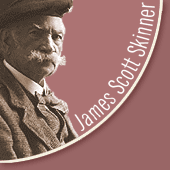




The Harp and Claymore Collection
Harp and Claymore Collection · JSS Other Collections · Discography
In 1904, The Harp and Claymore Collection, James Scott Skinner’s ‘magnum
opus’ – his biggest collection of dance music, airs and songs
was published.
Skinner was 60 and had a lifetime of learning, collecting and composing
tunes behind him. The collection was edited by Gavin Greig M.A. (1856-1914),
schoolmaster, essayist, playwright, organist and folk-song collector.
The Harp and Claymore Collection followed in the tradition of Skinner’s previous collections, being made up of dance music, airs and songs, all with a decidedly ‘Scottish‘ slant. Skinner was immensely patriotic, at a time when the nationalist movement was popular throughout Europe. In an age when academics and trained folklorists were interested in recording and preserving European folk culture, Skinner was writing down tunes that he had picked up through others’ playing, often handed down through the generations. Some of these tunes, along with many of his own, were presented back to the Scottish people they had come from through this volume.
The Harp and Claymore manuscript collection
Skinner’s Scotland
Like Skinner’s previous collections, The Harp and Claymore shares a ‘Scottish’ or patriotic, name. Skinner loved the Scottish countryside. He loved his local dialect. He loved tartan and the kilt. On his return from a disastrous Canadian tour in 1893, influenced by Professor J S Blackie, he decided to adopt Highland dress, and never again appeared on stage in conventional evening dress. Above all, he loved Scottish music, and especially bagpipe music – to him, that epitomised his Scotland. That is apparent from some of the titles: Bruce’s March (JSS0051), Ossian (JSS0021). So many of the titles or tune descriptions emphasize his patriotic feelings: some of his melodies are described as Patriotic Pastorals or Heroic Marches.
A wealth of information in the manuscripts
Skinner credited other composers
wherever possible, often including on his manuscripts, little anecdotes
about either the tune or the composer.
For example, look at JSS0085, ‘Note about Niel Gow’ or
JSS0177, ‘Note about Hector the Hero’.
These give an insight into his own influences – which tunes, players
or composers interested him, and why. We are fortunate that he was fond
of writing all over his manuscript music – what a wealth of information
can be gained from it! He didn’t just use music by other composers
in the collection because he liked it – Skinner often wrote variations
to popular Scottish tunes, such as to Nathaniel Gow’s ‘Largo’s
Fairy Dance’ (JSS0643). The variations have become just as well
known as the melodies themselves.
Other composers included in The Harp and Claymore Collection
Skinner used the following composers of fiddle music in his collection. Some are well known; some known only by a few and some have been forgotten.
- Airchie Allan
- Peter Baillie
- J Barnet
- John Bruce
- Donald Dow
- Capt. S. Fraser
- Nathaniel Gow
- Niel Gow
- William Gow
- Jamie Hardy
- James Hill
- Sir Alexander MacDonald
- Abraham Macintosh
- Robert Macintosh
- Duncan MacIntyre
- Angus Mackay
- A MacKellar
- Colin Macpherson
- James Macpherson
- William Marshall
- Alexander McGlashan
- Rory McLeod
- Peter Milne
- Robert Petrie
- James Porteous
- William Ross
- Miss Stirling of Ardoch
- Alexander Troup
Earlier publications
The bulk of The Harp and Claymore Collection comprises Skinner’s own work. Not everything was freshly composed – some of his music had been published before, often more than once. You may notice that some of the arrangements have already been printed and pasted onto a manuscript page. These compositions had appeared in some other format. The most common source in these cases in his publication, ‘The Scottish Violinist’, published in 1900. Music from the Scottish Violinist is easy to recognize. It was the only one of his collections not to include piano accompaniments, so the music was printed for fiddle only.
Arrangements and arrangers
Often the manuscripts are only partially complete. Not all of Skinner’s arrangements were used in the final selection – many of them, whether by Skinner or by someone else, were simplified or improved, before final publication. Skinner used a number of different arrangers, ranging from the local: Gavin Greig, George Riddell; to the international: Herr Adolph Roloff, a German, who taught at Tooting College of Music, London. Another German appears on the list of arrangers: Herr F Erkmann. It may be that Roloff and Erkmann had a connection with Dr Mark, with whom Skinner spent a six-year musical apprenticeship in the 1850s.
Comparing differences between the versions
When The Harp and Claymore Collection was published in 1904, Gavin Greig was just setting out on his mammoth task of collecting folk song of north east Scotland. As editor, he had the final say. His neat handwriting contrasts admirably with Skinner’s hurried scrawl. Greig copied out all Skinner’s manuscripts again, in their (almost) final versions, sometimes with very different accompaniments. We are very fortunate to have some of Greig’s final version of Harp and Claymore (JSS0577 – JSS0651). Some of the printer’s proofs are included here too. Look at the differences between versions of ‘The Valley of Silence’ (JSS0024, JSS0583, JSS0584, JSS0633). Sometimes different versions of the same melody appear in just Skinner’s collection ‘Le Messe’ (JSS0210 – JSS0216); sometimes there are differences between Skinner’s and Greig’s versions ‘Herr Roloff’s Farewell (JSS0183, JSS0626), and sometimes even the printer’s proof has been altered ‘Dumbarton Castle’ (JSS0636).
The Harp and Claymore manuscripts are a fascinating insight into how Skinner and Greig compiled their collection. They provide us with a wealth of knowledge about the tunes, and often about the people, places or occurrences they were dedicated to. We gain an insight into Skinner’s methods of teaching or composing. These manuscripts make a fascinating collection, well worth further study.
Pat Ballantyne
